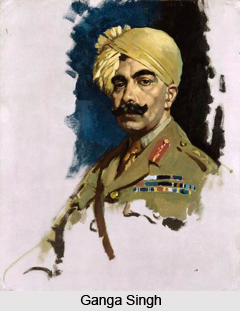 History of Bikaner district goes back a very long way. Its earliest history can be traced back to 1488 AD, when the Rajput Prince Rao Bikaji established his kingdom here. Rao Bikaji was a descendant of the founder of Jodhpur, Rao Jodhaji. RaoBikaji was the most lively and enterprising among the five sons of Rao Jodhaji of Marwar. Realizing that a struggle for his paternal inheritance was not likely to be fruitful, this adventurous price was determined to chart out his own destiny. Rao Bika gathered a force of young warriors, whose restless energy proved to be a powerful motivating force in confronting the hazards of the desert. At Deshnok, he sought the blessings of Karni Devi, a mystic Charan, who was held in high regard. She blessed him and prophesied his victory and he founded the state of Bikaner
History of Bikaner district goes back a very long way. Its earliest history can be traced back to 1488 AD, when the Rajput Prince Rao Bikaji established his kingdom here. Rao Bikaji was a descendant of the founder of Jodhpur, Rao Jodhaji. RaoBikaji was the most lively and enterprising among the five sons of Rao Jodhaji of Marwar. Realizing that a struggle for his paternal inheritance was not likely to be fruitful, this adventurous price was determined to chart out his own destiny. Rao Bika gathered a force of young warriors, whose restless energy proved to be a powerful motivating force in confronting the hazards of the desert. At Deshnok, he sought the blessings of Karni Devi, a mystic Charan, who was held in high regard. She blessed him and prophesied his victory and he founded the state of Bikaner
Bikaji chose the barren land of `Jungladesh` for his new kingdom. It has been established beyond doubt by the archaeological surveys and excavations that civilisation flourished here even before the advent of the Harappa period. Excavated statues, coins and carvings of stones and clay stand as testimony to this fact. Right from the foundation of Bikaner till its accession into the Indian union in the year of India`s Independence, 1947, and following this, its integration into the state of Rajasthan in 30-3-1949, Bikaner has continued to play an important role in the history of the country.
About 1465 Bika, a Rajput chieftain of the Rathor clan, began to conquer the area from other Rajput clans. In 1488 he began building the city of Bikaner ("the settlement of Bika"). He died in 1504, and his successors gradually extended their possessions. The state adhered loyally to the Mughal emperors, who ruled in Delhi from 1526 to 1857. In 1571, Rai Singh succeeded as the chieftain of Bikaner. He went on to become one of Emperor Akbar`s most trusted and distinguished generals, and was named the first Raja of Bikaner. As the dominance of the Mughal dynasty started to wane, wars between Bikaner and the princely state of Jodhpur raged intermittently in the 18th century. Finally, in the year 1818, a treaty establishing British paramountcy was concluded, and order was restored in the country by British troops. However, the rebellious behaviour of the local thakurs, or the subsidiary chiefs, continued. This happened right up until the princely state of Bikaner was made subject to the Rajputana agency in 1883. The military force of the state at the time included the Bikaner Camel Corps, which gained renown in China during the Boxer Rebellion (1900) and in the Middle East during World War I. In the year 1949, Bikaner, which by then totalled more than 23,000 square miles (60,000 square km) in area, became part of the Indian state of Rajasthan and was divided into three districts.



















